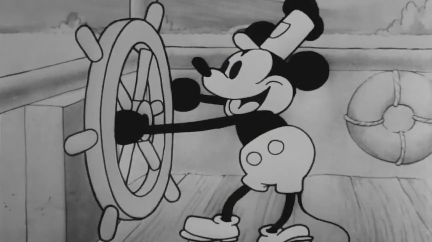

A version of Disney’s iconic Mickey Mouse–once a leading villain in the US copyright debate–has officially entered the public domain after 95 long years. Moving forward, anyone can reuse or reference the black and white Mickey and Minnie Mouse that appeared in 1928 films Steamboat Willie and Plane Crazy without fears of legal reprisals from Disney. The highly awaited expiration date marks an important moment for public domain advocates, who’ve long associated the goofy mouse with corporate efforts to extend the shelf-life of copyrighted works.
What is public domain and why is Mickey entering it?
Copyright laws are intended to protect the intellectual property (IP) created by individuals or businesses for a certain amount of time. These protections cover a wide variety of IP, from movies and music to books and creative characters like Mickey and are critical to ensuring creators can profit off their work. In the US, copyright protections generally expire 70 years after an author’s death or 95 years after publication.
Once expired, those works enter the public domain, where they can largely be used freely without requiring permission from the original author. Public domain advocates say reasonable copyright expiration dates are necessary to ensure the public has the opportunity to advance culture and archive significant works for the historical records. J.M. Barrie’s Peter Pan, Sherlock Holmes, and Winnie the Pooh are just a few examples of copyrighted works or famous characters that have entered the public domain in recent years.
The January 1, 2024 expiration means creators can basically do anything they want with Mickey, within reason. Mickey fans, for example, could use the mouse’s likeness in videos, stories, or even plastered on t-shirts. Mickey Mouse inspired slasher movies and horror video games are already reportedly in the works.
But there are some important exceptions. First, the copyright expiration only applies to the Mickey from 1928, which means the white gloved, bubbly-peyed Mickey most commonly associated with the Disney mouse is still protected under copyright. Creators also can’t use Mickey to create content that could mislead the public into believing their creation is endorsed by Disney.
Disney has a reputation for aggressively pursuing legal actions against people who violate their copyright and trademarks. Three daycare centers in Florida famously found themselves on the wrong end of a Disney legal threat in 1989 after they reportedly plastered images of Mickey, Minnie, and Donald Duck on their walls.
“If we were to allow them to use the characters, then we would have to allow everyone else to do so,” Disney spokesperson Chuck Champlin said at the time according to the Chicago Tribune. ”If we don’t protect our trademarks, we could lose our copyright and be out of business.”
Disney’s role in extending copyright
This week’s public domain inductees were a long time coming for many copyright critics, thanks in no small part to a controversial piece of 1998 federal legislation backed by Disney. At the time, copyright protections only lasted 50 years after an author’s death or 75 years after creation. Those limits were extended by 20 years following the passage of the Sonny Bono Copyright Term Extension Act. Disney reportedly supported the extension at the time, which led some critics to derisively refer to the law as the “Mickey Mouse Protection Act.” And with that, the Mickey Mouse copyright villain was born.
“The slow-motion arson attack on the public domain meant that two generations of creators were denied the public domain that every other creator in the history of the human race had enjoyed,” author and Electronic Frontier Foundation Special Adviser Cory Doctorow said of copyright extension in a recent blog post.
Disney’s hand wringing around copyright extensions, critics say, are made worse because many of the company’s most iconic works, like Frozen and The Lion King, actually draw inspiration from poems and music previously entered into the public domain. Mickey Mouse himself, Duke Center for the Study of the Public Domain Director Jennifer Jenkins notes, actually stems in part from the personalities and characteristics of silent film celebrities like Charlie Chaplin and Douglas Fairbanks.
Disney did not immediately respond to PopSci’s request for comment.
Looming copyright lawsuits could make public domain access essential for AI training
Large language models like OpenAI’s ChatGPT and various image generators like DALL-E and Stability AI’s Stable Diffusion currently inject billions of likely copyright protected works to train their model. But a plethora of copyright lawsuits filed by authors and creators could upend that model by making it illegal to train on protected works.
If the creators succeed, AI companies could be forced to drastically limit the types of IP their models are trained on. Those limitations could make access to material in the public domain essential for future AI models. For now though, AI companies and everyday creators alike can at least rest easy when it comes to reusing the classic Mickey.
